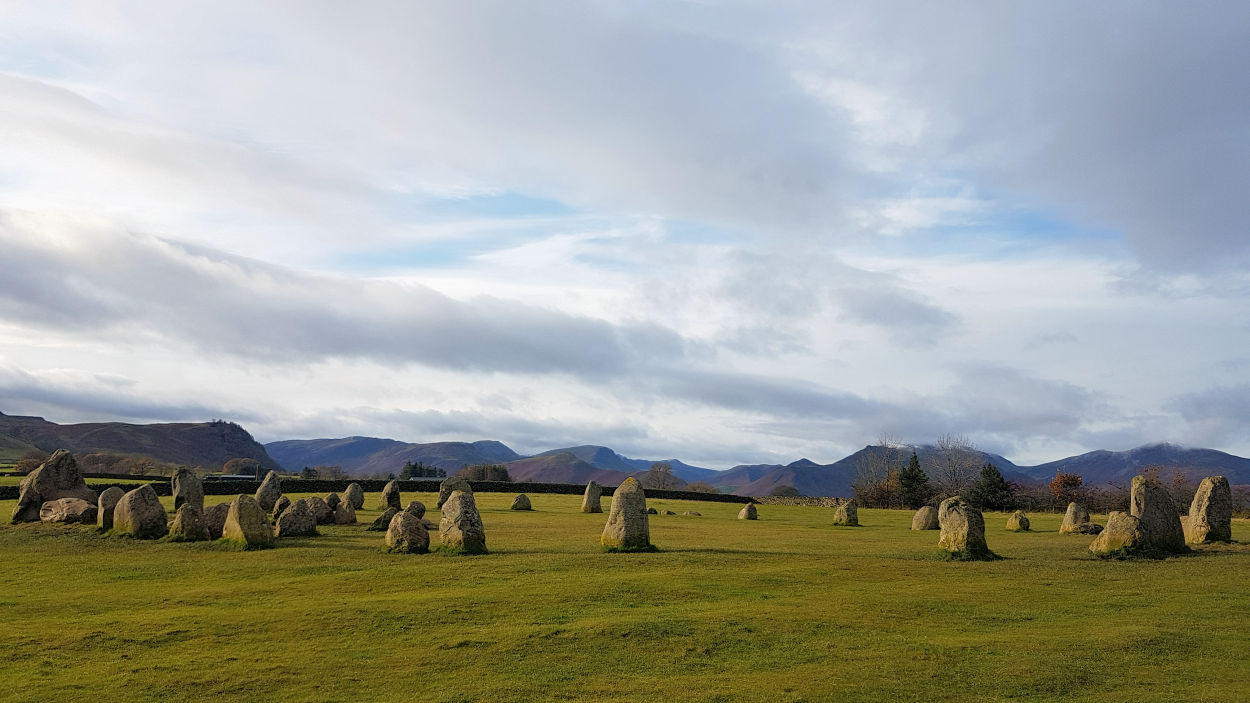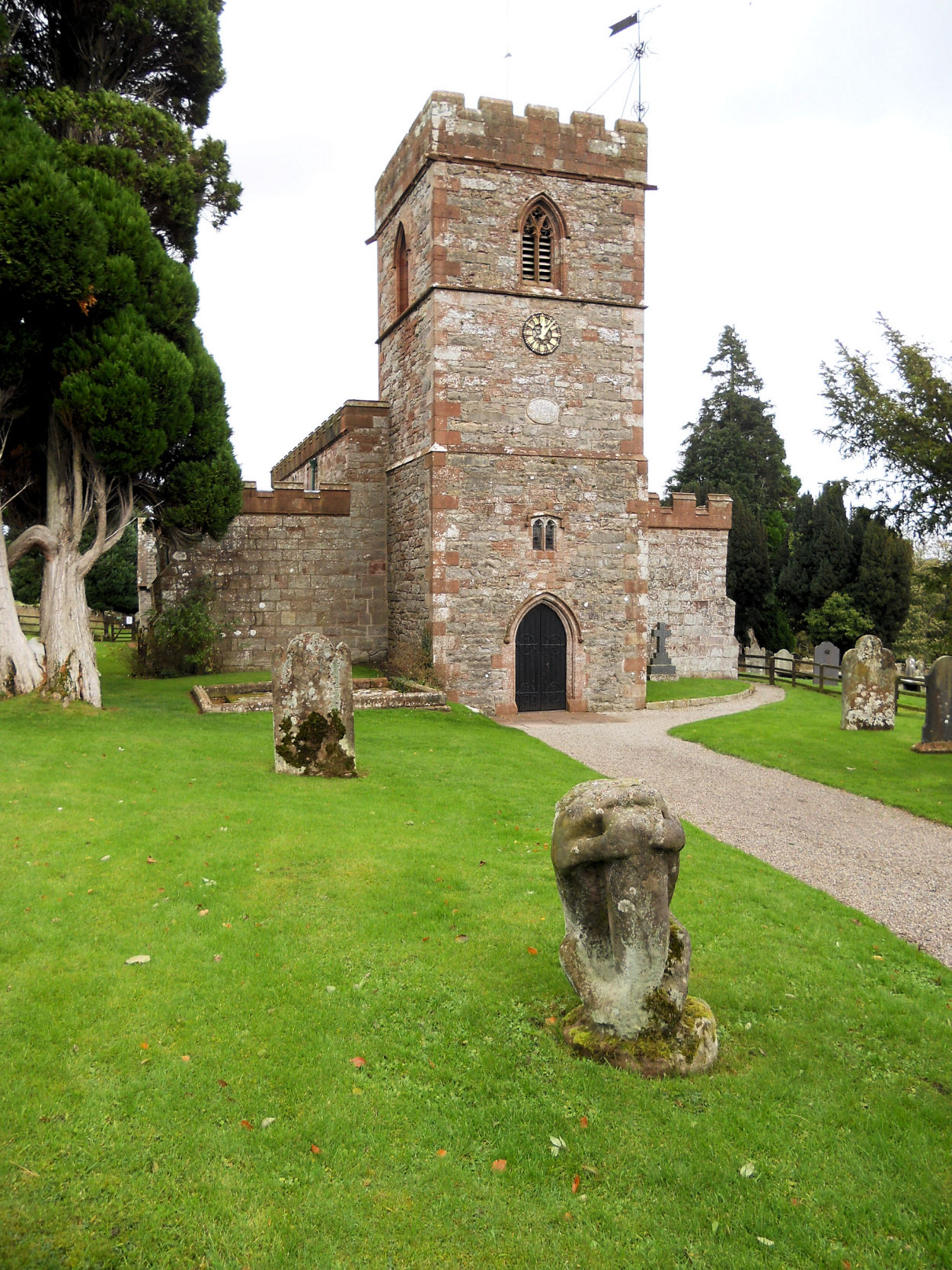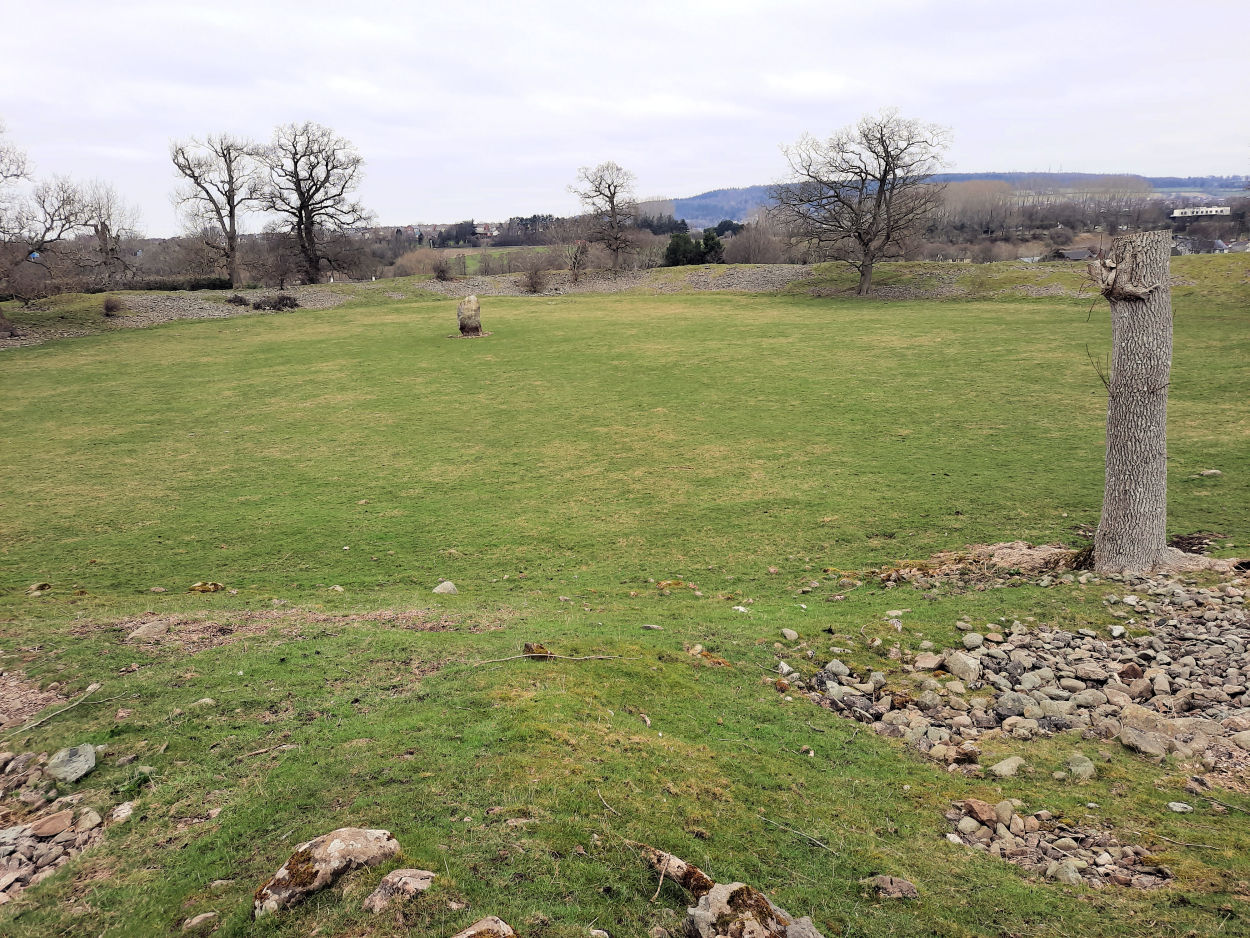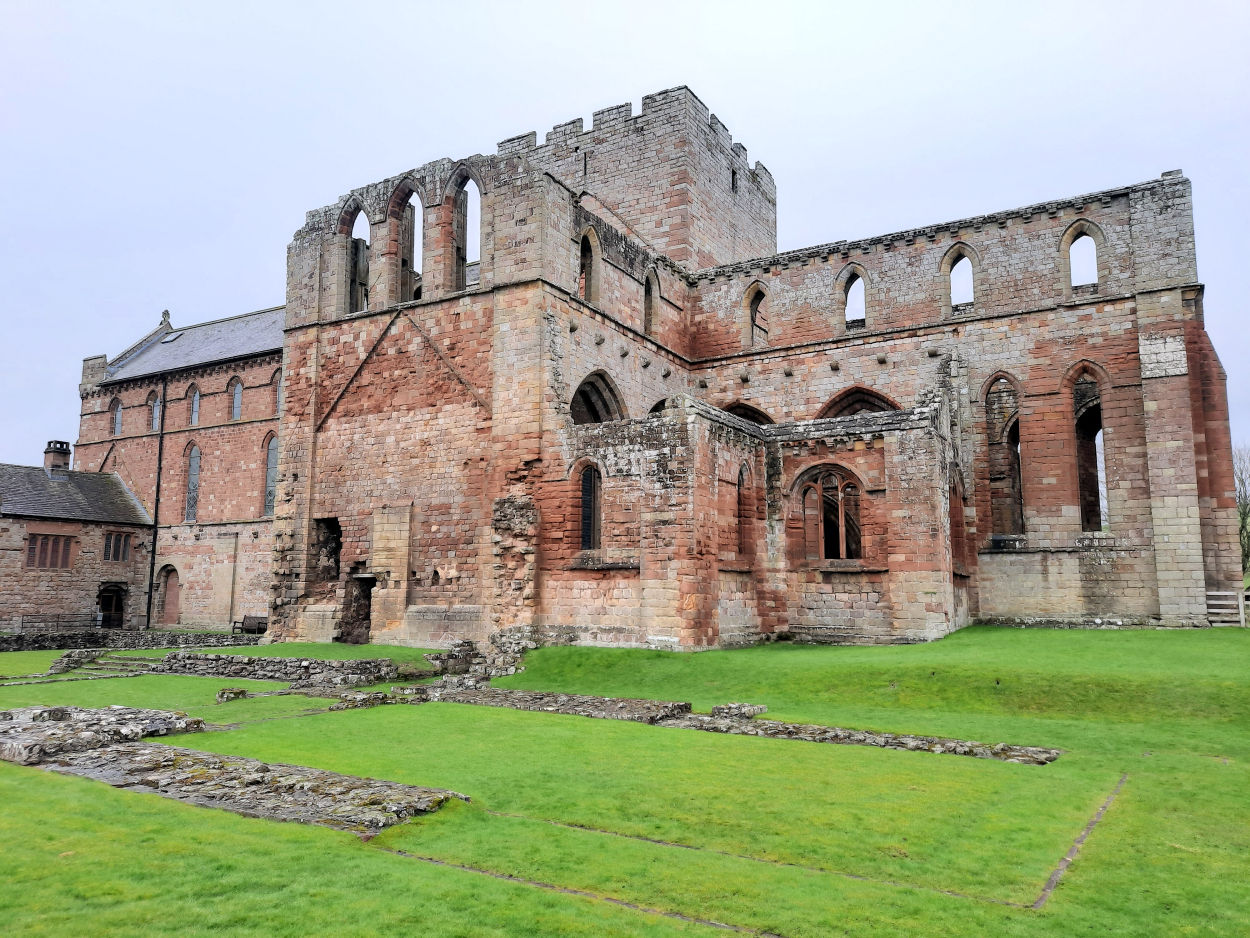Archaeology, Stone Circles, Romans, Castles & More


Castlerigg Stone Circle
![]()
![]()
Archaeology
![]()

The Dacre Bears www.dacrechurch.com
The Dacre Bears are a special feature at St. Andrew’s. There are four stone statues located within the churchyard. A recently expressed archaeological opinion is that they are pre-Saxon and may originally have marked the boundaries of some pagan sacred site, however the origin of the Bears is unknown and has been a puzzle for centuries.
Coniston Copper www.lakedistrict.gov.uk/learning/archaeologyhistory/coniston-copper
Walk the Coppermines Valley above Coniston www.walklakes.co.uk/walk_252.html
The Old Man of Coniston and its surrounding fells are well known for their ancient and modern mining and quarrying scars that dot the landscape. Coppermines Valley is this, concentrated into one small area. The valley floor is covered by tell tale spoil heaps, and foundations of long gone buildings. If you look carefully even remains of old leats can still be found which were used to transport water from becks and reservoirs high in the fells to where it was needed in the valley to generate power, or used in processing. Now only occasionally does the crump of blasting explosives confirm that at least one quarry in the valley lives on and is still worked.
![]()

Long Meg Stone Circle
![]()
Stone Circles
![]()

 Historic Uk www.historic-uk.com
Historic Uk www.historic-uk.com
Stone Circles in the Lake District and Cumbria. When one thinks of stone circles, the likelihood is that Stonehenge and Avebury are the first that come to mind. Cumbria, however, is one of the most densely populated regions for these prehistoric marvels, and also contains some of the most complete stone circles in England.
![]()
Visit Cumbria www.visitcumbria.com/stone-circle/
There are some 50 stone circles in the Lake District and Cumbria, including some of the earliest stone circles in Britain.
There is a vast range of types, from the vast monumental circles at Castlerigg, Swinside and Long Meg, to the standard early bronze age circles of about 100 ft in diameter as at Casterton and Elva Plain, to diminutive rings associated with alignments and burials. Some are associated with henge monuments such as Mayburgh.
![]()
Romans
![]()
Hadrians Wall www.hadrianswallcountry.co.uk
Discover over 1900 years of Hadrian's Wall. Stretching 73 miles from coast to coast, Hadrian’s Wall was built to guard the wild north-west frontier of the Roman Empire. Discover the remains of the forts, towers, turrets and towns that once kept watch over Hadrian’s Wall. See rare Roman artefacts, get hands-on in museums and take in spectacular views of the rugged landscape to find out what life was like for the men, women and children on the edge of Roman Britain.
![]()
Hadrians Wall Country hadrianswallcountry.co.uk
Hadrian’s Wall is the best preserved and most formidable of Rome’s great frontiers. Situated across over 100 miles of the World Heritage Site in the Coast, Countryside, and City, can be found key Roman sites and attractions. Visit these 10 Roman attractions to be transported back into the proud, pioneering heart of Rome.
![]()
Visit Cumbria www.visitcumbria.com
Romans in Cumbria and the Lake District - Roman Forts and Fortlets
![]()
Lake District National Park www.lakedistrict.gov.uk
Roman remains to visit
![]()
 Ravenglass Roman Bath House www.english-heritage.org.uk
Ravenglass Roman Bath House www.english-heritage.org.uk
The remains of the bath house of Ravenglass Roman Fort, established around AD 130, are among the tallest Roman structures surviving in northern Britain – the walls stand almost 4 metres high. The fort at Ravenglass (whose earthworks can be seen near the bath house) guarded what was probably a useful harbour, and there is evidence that soldiers stationed here served in Hadrian's fleet.
![]()
Hardknott Roman Fort www.english-heritage.org.uk
This remote and dramatically sited fort was founded under Hadrian’s rule in the 2nd century. Well-marked remains include the headquarters building, commandant’s house and bath house. The site of the parade ground survives beside the fort, and the road which Hardknott guarded can be traced for some distance as an earthwork.
![]()
 Senhouse Roman Museum www.visitlakedistrict.com
Senhouse Roman Museum www.visitlakedistrict.com
An internationally significant Roman collection housed in a Victorian Naval Battery adjacent to the Roman fort at Maryport. The museum is situated on the western end of Hadrian's Wall World Heritage Site overlooking the Solway Firth towards the Scottish coast. The collection includes Roman military altars, sculptures and objects that tell the story of Roman life and beliefs on the edge of the Empire.
![]()
Castles and More
![]()

Lanercost Priory
The beautiful and now tranquil setting of Augustinian Lanercost Priory belies an often troubled history. Standing close to Hadrian's Wall, it suffered frequent attacks during the long Anglo-Scottish wars, once by Robert Bruce in person. The mortally sick King Edward I rested here for five months in 1306-7, shortly before his death on his final campaign. Yet there is still much to see in this best-preserved of Cumbrian monasteries. The east end of the noble 13th-century church survives to its full height, housing within its dramatic triple tier of arches some fine monuments.
www.english-heritage.org.uk/visit/places/lanercost-priory
![]()
Visit Lake District www.visitlakedistrict.com/explore/cumbrian-castles
Cumbria’s castles are key to 2000 years of turbulent history. From the first forts built by the Romans to the mighty fortresses erected by the Normans, the Cumbrian castle was a necessary line of defence in a land under dispute, fought over for centuries in a back-and-forth that put the county at the heart of British history. The finest example is in Carlisle, where the castle – built with stones ‘borrowed’ from Hadrian’s Wall - was an eyewitness to some of English history’s most significant moments, but even the region’s earliest Norman churches look more like fortified towers.
Today you can visit some of Cumbria’s most impressive fortifications – or enjoy traipsing through ruins of those that weren’t so fortunate to survive history’s vicissitudes. And you can even stay in them – especially those castles built in Tudor times more for majesty and magnificence than safety and defence.
![]()
Kendal Castle - Kendal www.visit-kendal.co.uk
Built around 1200, the stone castle was built to replace the wooden motte and bailey on the opposite side of the river at Castle Howe. This 13th century castle, built on a drumlin (a glacial hill), was the seat of power and administration for the barons of Kendal for over 200 years, most notably the Parr family.
![]()
Carlisle Castle - Carlisle www.english-heritage.org.uk
Standing proud in the city it has dominated for nine centuries, Carlisle Castle remained a working fortress until well within living memory. It has withstood many sieges, held captive a royal prisoner, and been home to the King's Own Royal Border Regiment. Explore the medieval castle rooms, discover a turbulent history with the exhibition, and walk some of the castle walls. We're also home to Cumbria's Museum of Military Life.
![]()
Brougham Hall - Penrith www.broughamhall.co.uk
The perfect blend of crafts, coffee, and history Brougham Hall is a magnificent medieval building with a fascinating history, set in a stunning countryside location.Located just a mile south of Penrith in Cumbria, visitors can explore the Hall from dawn till dusk, while the workshops are open from 10 am to 5 pm, 7 days a week.
![]()
Sizergh Castle - National Trust, Nr Kendal www.nationaltrust.org.uk
Beautiful medieval house with rich gardens and estate. This imposing house stands proudly at the gateway to the Lake District and has been home to the Strickland family for more than 800 years. There’s plenty to explore on the 1,600-acre estate, including wetland, woodland and orchards – look out for fritillary butterflies, deer and rare hawfinches. If you’d rather relax in gardens, wander through the orchards, rock garden or stumpery or stroll along the herbaceous border and fruit wall – there's something new to see in every season.
![]()
Wray Castle - Ambleside www.nationaltrust.org.uk
Parkland and castle on the west shore of Windermere.Take a walk in the grounds at Wray and discover some of the features of this great estate, still much as they were when they were built, including an arboretum and yew walk, walled garden, boathouse, and miniature harbour. Follow waymarked trails through beautiful grounds, parkland and woodland including a long stretch of shingle beach on the shores of Lake Windermere and panoramic Lake District views, Wray has it all in every season.
![]()
Lowther Castle & Gardens - Penrith www.lowthercastle.org
Of the many treasures waiting to be discovered in the English Lake District, Lowther Castle is a particular gem. Built at the turn of the 19th century on the site of two previous houses, the castle was a grand affair boasting a room for every day of the year. Its gardens were the envy of the north. But in 1957 the castle was demolished. Just the façade and outer walls remained standing and for over half a century, the place was empty – home only to chickens, pigs and the odd bat. The gardens were lost to wilderness. Today Lowther Castle is one of the most intriguing visitor attractions in the country. Dramatic ruins, gardens within gardens, an adventure playground to rival the best in the land. We look forward to welcoming you.
![]()
Penrith Castle - Penrith www.english-heritage.org.uk
Penrith Castle was begun at the end of the 14th century by Ralph Neville, who played a key role in defending this area against the Scots. It was later transformed into a luxurious residence by Richard, Duke of Gloucester, who became Richard III. Surviving to their full height, the castle walls stand in a public park.
![]()
Muncaster Castle, Gardens & Estate - Ravenglass www.muncaster.co.uk
The Castle, nestled in Cumbria, believed to be standing on Roman remains, is a key part of the region’s history. Whilst the Pennington family have recorded evidence of this historic house as being their home since 1208 when lands were granted to Alan de Penitone, some records go back further suggesting that the family have been here since at least 1026.
![]()
Brougham Castle - Cumbria www.english-heritage.org.uk
In a picturesque setting beside the crossing of the River Eamont in Cumbria, Brougham Castle was founded in the early 13th century. This great keep largely survives, amid many later buildings - including the unusual double gatehouse and impressive 'Tower of League'. Both a formidable barrier against Scots invaders and a prestigious residence, the castle welcomed Edward I in 1300. A complex of passages and spiral stairways makes Brougham a fascinating castle to explore, as well as an ideal picnic setting for a family day out. Don't forget to head up to the top of the keep to enjoy panoramic views over the Eden Valley.
![]()

